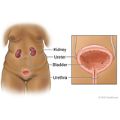overflow incontinence
conditions basics
what is overflow incontinence?
overflow incontinence means that you may have the urge to urinate, but you can release only a small amount. then later, urine leaks out. or it can mean that your bladder becomes too full and then leaks urine.
what causes it?
overflow incontinence can be caused by:
- conditions that affect the nerves. examples include diabetes and multiple sclerosis. they may make it hard to tell when your bladder is full. or they may make it harder for the bladder to contract.
- a blockage in the urinary tract. this blockage could be from uterine fibroids, from an enlarged prostate, or from scars that cause narrowing of the tube that carries urine out of the body (urethra).
- weakness in the muscle that expels urine from the bladder (detrusor). the bladder can't empty normally.
- certain medicines.
what are the symptoms?
symptoms of overflow incontinence include:
- an ongoing leaking or dribbling of urine, or the sudden release of urine.
- a feeling of fullness in the bladder even after urination.
- a urine stream that stops and restarts during urination.
- difficulty urinating even while feeling the urge to urinate.
how is overflow incontinence treated?
in women
women can be treated for overflow incontinence with:
- a pessary. a pessary fits into the vagina and supports the pelvic organs. it may be used if a pelvic organ moves out of its normal position (prolapse).
- a catheter. a catheter is a thin, flexible tube that allows urine to drain out. it is inserted into the bladder through the urethra. this may be a straight catheter, which is inserted several times a day. or it may be a suprapubic catheter, which is put into the bladder through a small cut in the belly.
- surgery. surgery may be needed to correct problems that cause overflow incontinence, such as obstructions or abnormal growths in the urinary tract.
- sacral nerve stimulation. an electrical stimulator under your skin sends pulses to the sacral nerve in your lower back. this nerve plays a role in bladder storage and emptying.
in men
men can be treated for overflow incontinence with:
- medicine. medicines can be used to make the prostate smaller. this relieves pressure on the urethra so the bladder can empty more normally. medicines can also help the urine flow better.
- a catheter. some men may need a catheter to allow the bladder to empty normally. if the bladder gets too full, the situation can become urgent. unless a catheter is used to drain the urine and relieve the pressure, the bladder and kidneys can be damaged.
- surgery. surgery for an enlarged prostate may include minimally-invasive procedures or transurethral resection of the prostate (turp).
in men and women
other treatments include treating constipation and stopping or reducing doses of medicines that might be causing the incontinence.
credits
current as of: november 15, 2023
author: healthwise staff
clinical review board
all healthwise education is reviewed by a team that includes physicians, nurses, advanced practitioners, registered dieticians, and other healthcare professionals.
current as of: november 15, 2023
author: healthwise staff
clinical review board
all healthwise education is reviewed by a team that includes physicians, nurses, advanced practitioners, registered dieticians, and other healthcare professionals.
